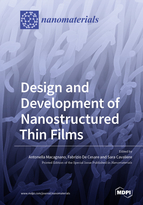Design and Development of Nanostructured Thin Films
A special issue of Nanomaterials (ISSN 2079-4991).
Deadline for manuscript submissions: closed (31 December 2018) | Viewed by 118903
Special Issue Editors
Interests: electrospinning technology; nanocomposite materials for sensors; environment; air pollutants; gas; chemical vapors; VOCs; SVOCs; atmospheric mercury active and passive sensing strategies
Special Issues, Collections and Topics in MDPI journals
2. Institute of Atmospheric Pollution Research - National Research Council (IIA-CNR), Research Area of Rome 1, Via Salaria km 29,300, 00016 Monterotondo, Italy
Interests: sustainable and low-impact agriculture; soil science; environmental science; environmental sensors and devices; environmental monitoring; nanomaterials; electrospinning
Special Issues, Collections and Topics in MDPI journals
Interests: materials for energy; nanomaterials; electrocatalysis; ionomer membranes; fuel cells; water electrolysis; electrospinning
Special Issues, Collections and Topics in MDPI journals
Special Issue Information
Dear Colleagues,
Nanostructured thin films have attracted a great deal of interest over the last few decades due to their unique, size-dependent, physicochemical properties. Consequently, they have been exploited as promising materials for a wide range of applications, including smart coating, effective drug delivery systems, electrocatalysis and highly-sensitive sensors. Depending on both the applications and the deposition technique, nanostructured films have been designed and developed by tuning their atomic-molecular 2D- and/or 3D-aggregation, thickness, crystallinity and porosity, as well as their optical, mechanical, catalytic and conductive properties. On the other hand, despite the wide benefits of nanostructures, there are open questions about how nanomaterial production and their daily use might affect the environment and health. Recently, many efforts have been made, not only to prevent nanotechnologies and nanomaterials from contributing to environmental pollution, but also to design nanomaterials aimed at protecting, supporting, and controlling the environment by employing various strategies.
This Special Issue will attempt to cover the recent advances in designing nanostructured films focusing on environmental issues, such as the fabrication processes (e.g., low-power and low-cost technologies, the use of environmentally-friendly solvents), the materials employed (e.g., waste-recycled, bio-based, biodegradable, and natural materials), the functions of thin films (e.g., controlled release of chemicals, mimicking of natural processes, energy conversion and storage), and use in environmental sensors (e.g., optically- or electrically-sensitive to pollutants).
Dr. Antonella MacagnanoDr. Sara Cavaliere
Dr. Fabrizio De Cesare
Guest Editors
Manuscript Submission Information
Manuscripts should be submitted online at www.mdpi.com by registering and logging in to this website. Once you are registered, click here to go to the submission form. Manuscripts can be submitted until the deadline. All submissions that pass pre-check are peer-reviewed. Accepted papers will be published continuously in the journal (as soon as accepted) and will be listed together on the special issue website. Research articles, review articles as well as short communications are invited. For planned papers, a title and short abstract (about 100 words) can be sent to the Editorial Office for announcement on this website.
Submitted manuscripts should not have been published previously, nor be under consideration for publication elsewhere (except conference proceedings papers). All manuscripts are thoroughly refereed through a single-blind peer-review process. A guide for authors and other relevant information for submission of manuscripts is available on the Instructions for Authors page. Nanomaterials is an international peer-reviewed open access semimonthly journal published by MDPI.
Please visit the Instructions for Authors page before submitting a manuscript. The Article Processing Charge (APC) for publication in this open access journal is 2900 CHF (Swiss Francs). Submitted papers should be well formatted and use good English. Authors may use MDPI's English editing service prior to publication or during author revisions.
Keywords
- nanostructured thin films
- low impact processes and materials (environmentally friendly, environmentally sustainable, waste-based, and bio-based)
- environmental applications
- controlled release of chemicals or active substances
- natural processes mimicking
- (bio)catalytic and electrocatalytic nanomaterials
- sensors
- biosensors
- clean energy
- energy conversion and energy storage









